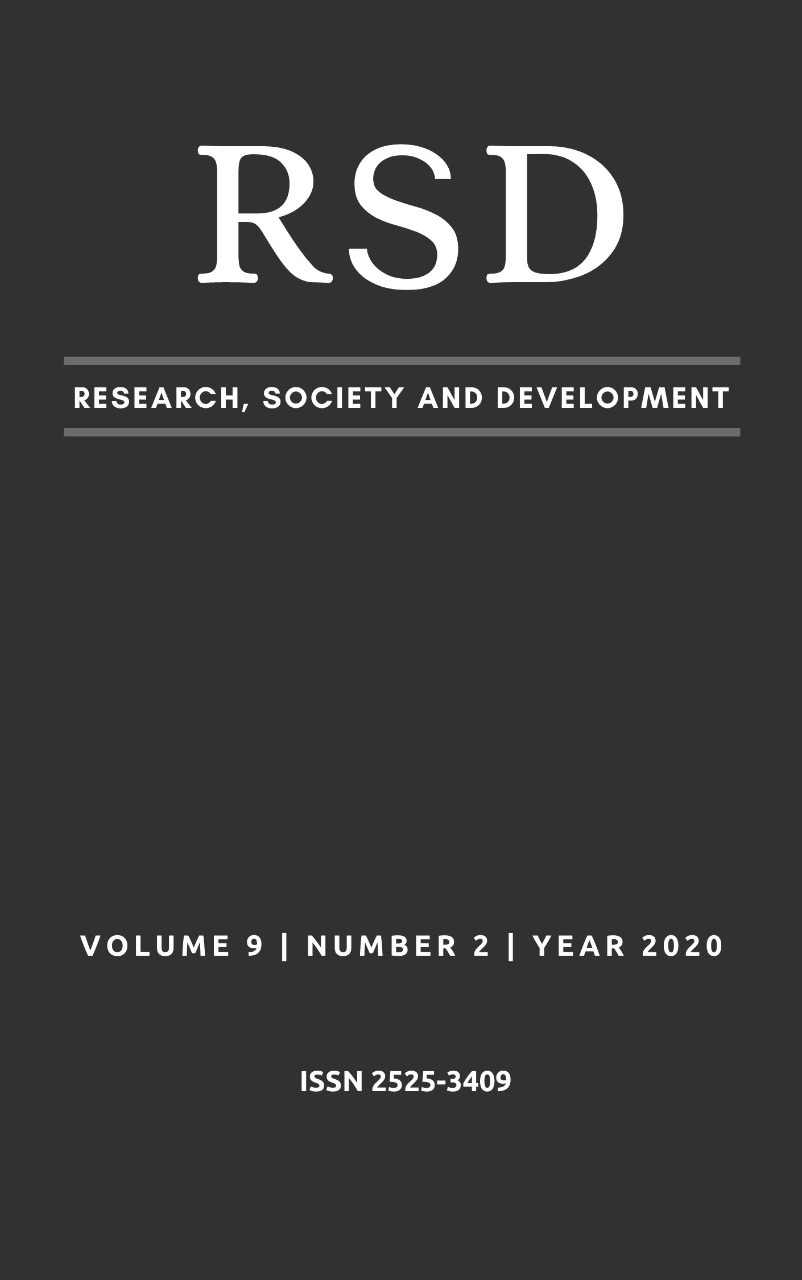Producción de alcohol de batata al variar las condiciones de fermentación e hidrólisis
DOI:
https://doi.org/10.33448/rsd-v9i2.2201Palabras clave:
Ipomoea batatas L., Saccharomyces cerevisiae, Hidrólisis, Bioetanol.Resumen
El bioetanol es un combustible como fuente alternativa de energía de importancia mundial. El presente estudio tuvo como objetivo evaluar la producción de alcohol a partir de batata, en diferentes condiciones de reacción para la fermentación e hidrólisis. Se seleccionó un genotipo para obtener harina seca y se procesó por hidrólisis ácida e hidrólisis enzimática con α-amilasa y amiloglucosidasa. El experimento se llevó a cabo en un diseño de bloques completamente al azar con tres repeticiones de puntos central, combinadas con la metodología de la superficie de respuesta. Las variables fueron pH, temperatura y tiempo de fermentación. El contenido de alcohol se determinó por destilación con análisis espectrofotométrico posterior. Las materias primas se caracterizaron por la humedad, los azúcares reductores y el almidón, obteniendo 4,13%, 4,04% y 71,80%, respectivamente. La hidrólisis ácida mostró mayores porcentajes de alcohol en las muestras destiladas. El 26,42% y el 25,04% valores fueron los más altos de hidrólisis ácida e hidrólisis enzimática en las fermentaciones, respectivamente, realizadas a pH 5,0 y 36°C durante 5 días. El tiempo de fermentación fue la variable más importante, con valores más altos y significativos para ambos tipos de hidrólisis. La hidrólisis ácida mostró un mayor potencial para la producción de alcohol que la hidrólisis enzimática en la fermentación de batata.
Referencias
Alves, R. M. V.; Ito, D.; Carvalho, J. L. V.; Melo, W. F. & Godoy, R. L. O. (2012). Estabilidade de farinha de batata-doce biofortificada. Brazilian Journal of Food Technology. Campinas, 15, 59-71. doi: 10.1590/S1981-67232012000100007.
Agência Nacional de Vigilância Sanitária. (2005). Resolução – RDC n° 263, de 17 de outubro de 2005. Regulamento técnico para produtos de cereais, amidos, farinhas e farelos.
Amit, S. K.; Uddin, M.; Rahman, R.; Islan, S. M. R. & Khan, M. S. (2017). A review on mechanisms and commercial aspects of food preservation and processing. Agriculture & Food Security. 6 (51). doi: 10.1186/s40066-017-0130-8.
Camargo, L. K. P.; Mógor, A. F.; Resende, J. T. V. & Silva, P. R. (2013). Establishment and molecular characterization of a sweet potato germplasm bank of the highlands of Paraná State, Brazil. Genetics and Molecular Research. 12 (4), 5574-5588. doi: 10.4238/2013.November.18.7.
Canilha, L.; Chandel, T. S. S. M.; Antunes, F. A. F.; Freitas, W. L. C. & Felipe, M. G. A. (2012). Bioconversion of Sugarcane Biomass into Ethanol: an overview about composition, pretreatment methods, detoxification of hydrolysates, enzymatic saccharification and ethanol fermentation. Journal of Biomedicine and Biotechnology. 15 p. doi: 10.1155/2012/989572.
Cantos-Lopes, A.; Resende, J. T. V. de; Machado, J.; Guerra, E. P. & Resende, N. V. (2018). Alcohol production from sweet potato (Ipomoea batatas (L.) Lam.) genotypes in fermentative medium. Acta Agronômica. 67, 231-237. doi: 10.15446/acag.v67n2.65321.
Food and Agriculture Organization of the United Nations. Faosta, Sweet Potatoes, Production Quantity (Tons) - for All Countries. (2017). Retrieved from: http://www.fao.org/faostat/en/#search/Sweet%20potatoes.
Ferrari, M. D.; Guigou, M. & Lareo, C. (2013). Energy consumption evaluation of fuel bioethanol production from sweet potato. Bioresource Technology. 136, 377–384. doi: 10.1016/j.biortech.2013.03.045.
Instituto Adolfo Lutz. (2005). Brasil. Ministério da Saúde. Agência Nacional de Vigilância Sanitária. Métodos físico-químicos para análise de alimentos. Brasília: Ministério da Saúde.
Pavlak, M. C. M; Abre-Lima, T. L.; Carreiro, S. C. & Paulillo, S. C. L. (2011). Estudo da fermentação do hidrolisado de batata-doce utilizando diferentes linhagens de Saccharomyces cerevisiae. Química Nova. 34 (1), 82-86. doi: 10.1590/S0100-40422011000100016.
Pereira, C. R.; Resende, J. T. V.; Guerra, E. P.; Lima, V. A.; Martins, M. D. & Knob, A. (2017). Enzymatic conversion of sweet potato granular starch into fermentable sugars: Feasibility of sweet potato pell as alternative substrate for a-amylase production. Biocatalysis and Agricultural Biotechnology. 11, 231-238. doi: 10.1016/j.bcab.2017.07.011.
Schweinberger, C. M.; Trierweiler, J. O. & Trierweiler, L. F. (2019). A simple equation for toral reducing sugars (TRS) estimation on sweet potato and ethanol yield potential. Brazilian Journal of Chemical Engineering. 36 (01), 33 – 41.
Silva, J. O. V.; Almeida, M. F.; Alvim-Ferraz, M. da C. & Dias, J. M. (2018). Integrated production of biodiesel and bioethanol from sweet potato. Renewable Energy. 124, 114-120. doi: 10.1016/j.renene.2017.07.052
Srichuwong, S.; Orikasa, T.; Matsuki, J.; Shiina, T.; Kobayashi, T. & Tokuyasu, K. (2012). Sweet potato having a low temperature-gelatinizing starch as a promising feedstock for bioethanol production. Biomass and Bioenergy. 39, 120-127. doi: 10.1016/j.biombioe.2011.12.023.
Tian, S., Zhao, R. & Zhao, J. (2018). Production of bioethanol from sweet potato tubers with different storage times. Bio Resources. 13(3), 4795-4806.
Woiceienchowski, A. L.; Nitsche, S.; Pandey, A. & Soccol, C. R. (2002). Acid and enzymatic hydrolysis to recover reducing sugars from cassava bagasse: an economic study. Curitiba: Brazilian Archives of Biology and Technology. 45 (3), 393-400. doi: 10.1590/S1516-89132002000300018.
Descargas
Publicado
Número
Sección
Licencia
Los autores que publican en esta revista concuerdan con los siguientes términos:
1) Los autores mantienen los derechos de autor y conceden a la revista el derecho de primera publicación, con el trabajo simultáneamente licenciado bajo la Licencia Creative Commons Attribution que permite el compartir el trabajo con reconocimiento de la autoría y publicación inicial en esta revista.
2) Los autores tienen autorización para asumir contratos adicionales por separado, para distribución no exclusiva de la versión del trabajo publicada en esta revista (por ejemplo, publicar en repositorio institucional o como capítulo de libro), con reconocimiento de autoría y publicación inicial en esta revista.
3) Los autores tienen permiso y son estimulados a publicar y distribuir su trabajo en línea (por ejemplo, en repositorios institucionales o en su página personal) a cualquier punto antes o durante el proceso editorial, ya que esto puede generar cambios productivos, así como aumentar el impacto y la cita del trabajo publicado.


